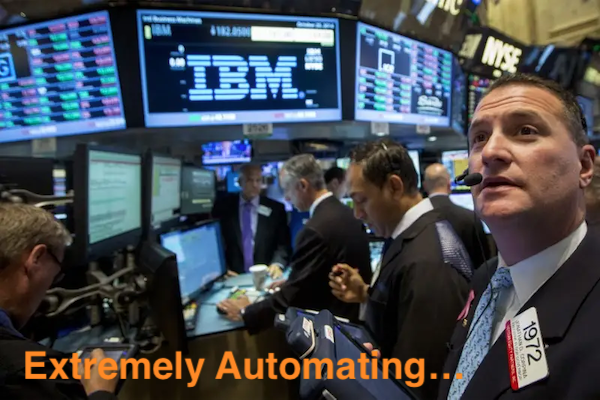How to choose a robot for your company

There are lots of reasons a company might entertain automating processes with
robots. According to Kern, the main reason is a labor shortage. Prior to
COVID-19-related slowdowns, a competitive labor landscape and rising costs of
living in many countries around the globe made hiring tough for skilled and
unskilled positions alike. Automation, which often promises ROI efficiencies
over time, particularly when it comes to repeatable tasks, is an attractive
solution. "Robots can save money over time, not just by directly
eliminating human labor, but by cutting out worker training and turnover,"
according to the Lux report for which Kern served as lead. "Most companies
turn to automation and robotic solutions to deal with labor shortages, which
is common in industries with repetitive tasks that have a high employee
turnover rate. Companies also frequently use robots to automate dangerous
tasks, keeping their employees out of harm's way." Post-COVID-19, there are
also considerations like sanitation and worker volatility. As I've written,
the perception of automation is changing almost overnight. Where robots were
once, very recently, associated primarily with lost jobs, there's been a new
spin in the industry to tout automation solutions as commonsense in a world
where workers are risking infection when they show up at physical locations.
How the cloud fractures application delivery infrastructure ops

The traditional infrastructure team still operates ADCs and load balancers in
the data center, while preferring the vendors they have worked with in the
past. DevOps and CloudOps have taken control in the public cloud, choosing to
use software and cloud provider services that are more integrated with their
DevOps toolchains. This fractured operations model is problematic. Companies
with divided Layer 4-7 operations are less likely to be successful with this
infrastructure. EMA research participants also revealed why they feel a need
to close this operational gap. First, 43% of enterprises said this situation
has introduced security risks. In most enterprises, application delivery
infrastructure is an important component of overall security architecture.
Companies need to take a unified approach to network security. Research
participants identified compliance problems (36%) and operational efficiency
(36%) as the top secondary challenges associated with fractured operations.
And 30% said platform problems -- such as issues with scale, performance,
functionality or stability -- are a major challenge.
The enormous opportunity in fintech

Technology providers to specific areas of finance have created significant
businesses. Across the insurance ecosystem, Guidewire, Applied Systems, and
Vertafore capture $10 billion of value. BlackKnight, the leading analytics
provider to the mortgage industry, is an $11 billion business. Are you
thinking about managing financial documents for your public company? You may
turn to Broadridge, which makes a pretty penny in this business, boasting a
$13 billion market cap. While these are massive markets, it is not easy to
disrupt incumbents. A combination of regulatory hurdles, entrenched behavior,
low risk-tolerance, and the benefits of larger balance sheets have kept
upstarts at bay for decades. However, as venture capital supports the
ecosystem, modern technology creeps into the sector (cloud, APIs),
connectivity and data exchanges improve, and consumers grow tired of
incumbents, the tide continues to shift. This shift and the challenge to the
status quo by fintech upstarts will have lasting effects. Even when incumbents
acquire their biggest disruptors, such as Visa’s acquisition of Plaid,
innovations pioneered by those startups become integrated into the system and
help move the industry forward.
Somehow, Microsoft is the best thing to happen to Chrome

What strange times we live in. Who’d have thought that I’d be writing an
article on how Microsoft is the best thing to happen to Google Chrome? A few
years ago the idea of Microsoft getting involved in an open source project
would cause a mixture of laughter and dread. You know… Microsoft, the foe of
open source who had a CEO that once said that Linux was “a cancer that
attaches itself in an intellectual property sense to everything it touches.”
The company that couldn’t make a decent web browser to save its life. But,
believe it or not, I really do think that Microsoft’s involvement has made
Chrome a much better browser. ... Basically, since dropping its opposition to
open source, and not only embracing it, but putting its money where its mouth
is, the thought of Microsoft being involved with an open source project is no
longer the stuff of nightmares. It’s proved to be a valuable contributor to
the open source community already. But how does this affect Google’s Chrome
browser? Well, ever since Microsoft stopped using its own web engine,
EdgeHTML, for its Edge web browser, and instead built a brand-new version
that’s based on Chromium, it’s been contributing a steady stream of fixes and
new features to Chromium – and those have not just been benefitting Edge, but
Chrome as well.
IBM just changed the automation game. Hello Extreme Automation

The technology provides a low code, cloud-based authoring experience for the
business user to create bot scripts with a desktop recorder, without the need
of IT. These scripts are executed by digital robots to complete tasks. Digital
robots can run on-demand by the end-user or by an automated scheduler.
Arguably, WDG is on a par with Softomotive – acquired by Microsoft for
considerably more money. What is clear is these RPA firms are offering pretty
much the same functionality for the basic scripting and recording. WDG
is focused heavily on quality customer service ops and is great at integrating
with chatbots, digital associates and other AI tools. Pre-Covid, most RPA was
focused on low-risk back-office processes, especially in finance. Now
customers are desperate to automate the customer-facing and revenue-generating
processes and need tools proven to work in the environments. Noone has a huge
advantage in the CX automation space so this provides a greenfield opportunity
for IBM. The WDG automation software sits under IBM Cognitive and Cloud
giving it a broader playing field to compete with the likes of MSFT, Pega,
Appian, and even ServiceNow. Arguably, this is the real play that excites
IBM’s top brass.
The Importance of Domain Experience in Data Science

Restated — domain knowledge is the learned skill to communicate fluently in a
group’s data dialect. Its component parts are: general business acumen +
vertical knowledge + data lineage understanding. For example, a data scientist
in people analytics requires a foundational knowledge of the business + human
resources + the inner-workings of their company’s HR tools and processes which
create the data they work with. Those processes and other inputs to the
dataset are crucial. A data scientist can’t create meaningful insights before
they understand what the data is saying today. Is it telling a story? Is it,
or subsets of it, too polluted to use today? Are some data points proxies for
or inputs to others? The more complex your business processes and associated
data lineage, the longer your data dialect will take to learn. For digital
native companies whose data collection is automated with intuitive dialects
(i.e. a “click” is a “click”), domain knowledge can be developed much more
quickly than for large, longstanding companies which have undergone
transformations, acquisitions and/or divestitures. If you hire a data
scientist, how long will it take them to learn your data dialect? And can you
provide air cover for them to do so before applying pressure to produce
“insights?”
Hiring developers: While coding is important, there are other things to consider

A recruiter can learn a lot about the candidate in that half hour, including
any side projects they might be involved in or games they've written. These
"are often a window into a developer's willingness to take initiative,"
Volodarsky said. Learning what a developer does in their spare time can also
provide great insight into their personality, he said. "Hiring great coders is
important, but you also want to collaborate with interesting people, too."
When it comes to hiring freelance developers it's important that they
understand both the code and the nuances of the business they're contracting
for, and this will come through in that conversation over a falafel, or the
like, he said. In terms of motivating factors, not surprisingly, an
overwhelming 70% said they were looking for better compensation, while 58.5%
said they want to work with new technologies, and 57% said they were curious
about other opportunities. Close to 70% of respondents said they learn about a
company during a job hunt by turning to reviews on third-party sites such as
Glassdoor and Blind. However, a large number also said they learned from
viewing company-sponsored media, such as blogs and company culture videos.
Is Singapore ready to govern a digital population?

Singapore over the past several years has invested significant resources
towards becoming a digital economy, rolling out an ambitious smart nation
roadmap, driving the adoption of emerging technologies, and overhauling its
own ICT infrastructure. With the global pandemic now adding new impetus
to digital transformation, the government has made a concerted effort to drive
digital adoption deeper into the business community and local population. It
established a new office to work alongside the business community and local
population to push the "national digitalisation movement". Initiatives would
include the deployment of 1,000 "digital ambassadors" to help stallholders and
seniors go digital and setting up of 50 digital community hubs across the
island to offer one-to-one assistance on digital skills. A new ministerial
committee will also coordinate the country's digitalisation efforts and focus
on priorities such as assisting people in learning new skills and galvanising
small businesses to go digital. More funds and resources have been further
directed to facilitate digital transformation initiatives.
AIOps tools expand as users warm slowly to autoremediation

AIOps has generated industry hype since 2017, as advances in machine learning
algorithms prompted IT monitoring vendors to envision a new method of
automation for their products. At the same time, complex microservices
infrastructures became impossible to manage entirely by human hands alone.
Since then, AIOps tools have grown more sophisticated, adding automated
remediation features to event correlation and automated root cause analysis,
and AIOps vendors that began in specialized areas have also broadened the
workloads their tools can support. Most recently, those vendors include
Epsagon, which emerged in 2018 with AI-supported distributed tracing for
serverless environments and expanded in 2019 to include container and cloud
workloads. It now offers AIOps features it calls Applied Observability, which
automate menial incident resolution tasks in response to metrics and logs in
addition to traces. Last month, Epsagon launched a partnership with Microsoft
centered on Kubernetes environments after previously inking a deal with AWS
focused on its Lambda serverless compute service.
How Microfrontends Can Help to Focus on Business Needs
The concept of building sites from small web applications integrated via
hyperlinks is (still) very common. There have also been a lot of concepts of
rendering pages from smaller, independent building blocks in the past, such as
Java Portlets. Even if the term microfrontend nowadays is used to refer to
modern JavaScript apps, there are multiple possible approaches. So, when I use
it in this article I refer to an application that: is basically a
JavaScript Rich Client (for example a SPA or a Web Component) that runs
isolated within an arbitrary DOM node and is as small and performant as
possible; does not install global libraries, fonts, or styles; does not
assume anything about the site it is embedded in; especially it does not
assume any existing paths, so all the base paths to assets and APIs must be
configurable; has a well-defined interface consisting of the startup
configuration and some runtime messages (events); should be
instantiable; ideally inherits the shared styles from the site and ships
only styles absolutely necessary to define its layout.
Quote for the day:
No comments:
Post a Comment